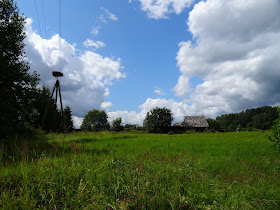The
decision to pass through Salacgrīva and continue on to Ainaži on our search for dinner was a
fateful one, as it meant spending the next hour or so in traffic. The 7.5 miles
between towns was almost entirely one-way traffic due to construction, the
Rīga/Talinn being improved and widened. At each stop we sat for what seemed an unbearably long time, waiting for oncoming traffic to clear, wishing for a
restaurant to be just around the next bend. One failed attempt not far out of
Salacgrīva (the place was closed for a wedding… on a Tuesday!) netted us the
name of a restaurant in Ainaži
that turned out to be open and serving – the only two requirements we had with
three hungry boys complaining in the backseat.
Ainaži is a quiet town, known for the
history of seafaring and shipbuilding; tourists can visit the sea school museum
which also touches on the construction of tall ships in the 19th and
20th centuries. The town was occupied by Estonia in 1919, although
the majority of the territory was returned to Latvia and vacated by Estonian troops by 1920,
with the exception of Ikla.
To
reach the center of Ainaži
we turned off of interstate A1, and it was this business route that
unassumingly dumped us into Estonia – no fanfare, no border crossing, just a
few flags and signs to let us know we were no longer in Latvia. Ikla is a small
village, part of Häädemeeste Parish in Pärnu County, and its claim to fame
seemed to be the Ikla rändrahn.
Per the informative signage: “The Erratic Bolder, whose sad story we are going to
tell you, probably arrived at Ikla already at the end of the 1st Ice
Age. Although the oldest date about the Bolder in the church register goes as
far back as 825 AD. The fate of the Erratic Bolder was gloomy in the dark
middle Ages. But its outer cold hard rock hid tender inner soul (the measure of
which is 26,000m3). During its life, weighing over 60 tonnes, it had to suffer
from local’s continual repression. It is difficult to describe all those horrors.
For example, the Erratic Boulder had to tolerate that superstitious people
continuously heaped a lot of food on it in the hope that fairies would bring
them luck. Actually only the Erratic Boulder saw that several and several
generations of crows and seagulls lived on it. But the Bolder did not tolerate
the birds, because they disturbed and smeared it, not to say anything of
contaminated food which made it feel sick. For centuries the local youth
climbed to the top of it and danced on it, mocking at its enormous
circumference, carving their names and causing wounds and leaving scars in it.
Once local people poked a fir-tree into the body of Stone Landmark who was a
good neighbor of the Erratic Boulder. The Boulder was sad, but it could not do
anything but feel sorry for the Stone Landmark. The nights, when ferns were in
blossom, were the most horrible for the Boulder. Then local people used to
throw a party and light bonfires near it. Because of that the western side of
the Boulder was overheated and it caused extreme pain to it every year on the
shortest night. One day it was noticed that the Boulder had disappeared. There
was nothing in the place where the Boulder had been for centuries. The most
famous scientists in the field were asked to come and investigate measure,
analyze and speculate, but they could not comment on its disappearance. The
Erratic Boulder had become a media star overnight. Journalists arrived,
questioned people, invented their own versions about the disappearance of the
Boulder and published them in their newspapers. In the end the prevailing
opinion was that the disappeared Boulder was a “rolling stone” by its nature
and that is why it had to rollaway. But some people were of the stile of the
opinion that the disappearance of the Boulder was caused by the exchange of the
local authorities and it was deeply insulted as its location was on the border
of the country. Nobody knows where the Ikla’s Erratic Boulder is now. Perhaps
it remains a secret for ever. Every year tens of people go missing who can
never be found, let alone an Erratic Boulder with a stone heart.”
So.
There you have it. The story of the erratic (bolder) boulder. I take absolutely
no credit for the translation!
We
wandered around for a bit (probably looking quite suspicious to anyone paying
attention), checking out the site of the old site of the border crossing
station and the concrete border markers. There was a ditch running between the
two countries, some official looking posts with ģērboņi and emblems, the highway signs
and quite a few maps detailing cycling routes.
And so
it came to be that Vilis had a snack in Estonia.
The
welcome back into Latvia was not nearly half as grand…
On our
way south we kept our eyes peeled for that rolling stone, but you know what? We never did see
it… quite a mystery!
P.S. Today is your final chance to enter the giveaway to win a made-in-Latvia banana bird market tote!
P.S. Today is your final chance to enter the giveaway to win a made-in-Latvia banana bird market tote!



















































